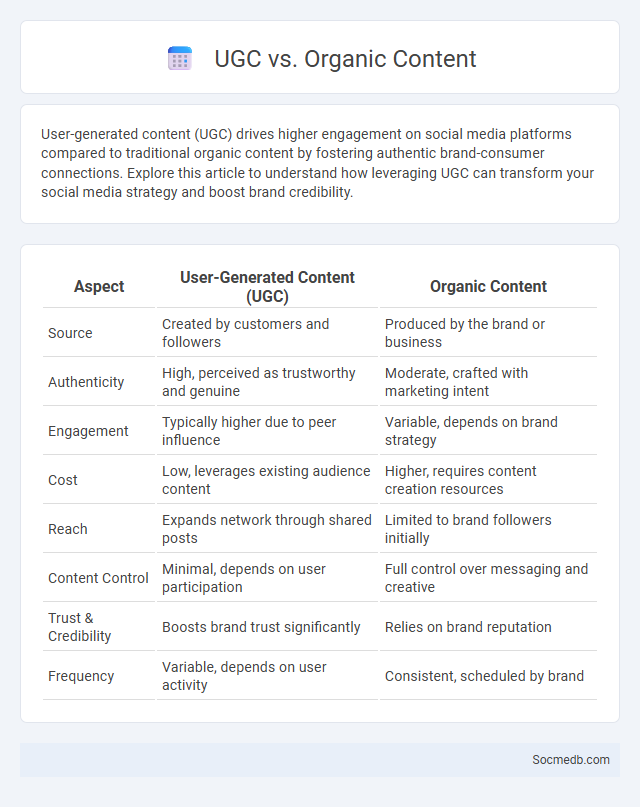
Photo illustration: UGC vs Organic Content
User-generated content (UGC) drives higher engagement on social media platforms compared to traditional organic content by fostering authentic brand-consumer connections. Explore this article to understand how leveraging UGC can transform your social media strategy and boost brand credibility.
Table of Comparison
| Aspect | User-Generated Content (UGC) | Organic Content |
|---|---|---|
| Source | Created by customers and followers | Produced by the brand or business |
| Authenticity | High, perceived as trustworthy and genuine | Moderate, crafted with marketing intent |
| Engagement | Typically higher due to peer influence | Variable, depends on brand strategy |
| Cost | Low, leverages existing audience content | Higher, requires content creation resources |
| Reach | Expands network through shared posts | Limited to brand followers initially |
| Content Control | Minimal, depends on user participation | Full control over messaging and creative |
| Trust & Credibility | Boosts brand trust significantly | Relies on brand reputation |
| Frequency | Variable, depends on user activity | Consistent, scheduled by brand |
Introduction to UGC, Organic Content, and User-Generated Content
User-Generated Content (UGC) plays a vital role in social media by fostering authentic engagement through content created directly by users rather than brands. Organic content, which stems naturally from users without paid promotion, enhances your social media presence by building trust and encouraging community interaction. Leveraging UGC and organic content effectively boosts credibility, increases reach, and drives meaningful conversations around your brand.
Defining UGC: What Is User-Generated Content?
User-generated content (UGC) refers to any form of content--such as text, images, videos, reviews, or social media posts--created and shared by users rather than brand professionals. UGC is authentic, engaging, and often serves as social proof, influencing purchasing decisions and enhancing brand trust. Platforms like Instagram, TikTok, and YouTube thrive on UGC, which drives organic reach and community interaction.
Understanding Organic Content: Meaning and Importance
Organic content on social media refers to posts, images, videos, and stories shared naturally by users without paid promotion. Understanding the meaning and importance of organic content helps you build genuine engagement, strengthen your brand's credibility, and foster loyal community connections. Leveraging organic strategies enhances your reach and interactions by creating authentic, relatable content that resonates with your audience.
Key Differences: UGC vs. Organic Content
User-Generated Content (UGC) is created by consumers and features authentic experiences, often enhancing trust and engagement on social media platforms. Organic content, produced by brands or businesses, is strategically designed to promote brand messaging without paid amplification. Understanding these key differences helps you optimize your social media strategy by balancing genuine user interactions with targeted brand communications.
Types of UGC and Organic Content Examples
User-generated content (UGC) on social media includes photos, videos, reviews, testimonials, and blog posts created by consumers that enhance brand authenticity. Organic content examples encompass unpaid posts such as personal stories, product usage tips, event experiences, and community discussions shared by users. These content types foster genuine engagement and build trust by showcasing real customer interactions and experiences.
Benefits of UGC for Brands and Businesses
User-generated content (UGC) boosts brand credibility by showcasing authentic customer experiences and social proof, increasing trust and engagement. UGC enhances content diversity, reducing marketing costs while providing fresh, relatable material that resonates with target audiences. Brands leveraging UGC often see higher conversion rates, improved SEO performance, and stronger community building on social media platforms.
Organic Content Strategies for Engagement
Organic content strategies for social media engagement emphasize authentic interactions by leveraging user-generated content, storytelling, and consistent posting tailored to target audiences. Prioritizing platform-specific algorithms, such as Instagram's emphasis on reels and Facebook's groups, maximizes reach without paid promotions. Analyzing engagement metrics like comments, shares, and watch time refines content approach, fostering loyal communities and sustained growth.
How to Encourage UGC from Your Audience
Encouraging user-generated content (UGC) involves creating engaging campaigns that motivate your audience to share their experiences with your brand. Offering incentives such as contests, giveaways, or featuring users' content on your official channels significantly boosts participation rates. Clear calls-to-action and easy submission processes further enhance user involvement, driving authentic content creation and strengthening community engagement.
UGC vs. Organic Content: Which Drives More Value?
User-generated content (UGC) often drives more value than organic content by fostering authentic engagement and trust among audiences. Your brand benefits from UGC as it encourages loyal customers to share genuine experiences, boosting credibility and expanding reach organically. Research shows UGC delivers higher conversion rates and stronger emotional connections compared to traditional organic posts.
Best Practices for Blending UGC and Organic Content
Blending user-generated content (UGC) with organic content enhances brand authenticity and drives higher engagement across social media platforms like Instagram, Facebook, and TikTok. Best practices include curating high-quality UGC that aligns with brand values, encouraging community participation through contests or hashtags, and maintaining a consistent posting schedule that balances branded messages with genuine customer stories. Incorporating analytics tools to monitor performance and audience sentiment helps optimize content strategy for increased reach and conversion rates.
 socmedb.com
socmedb.com